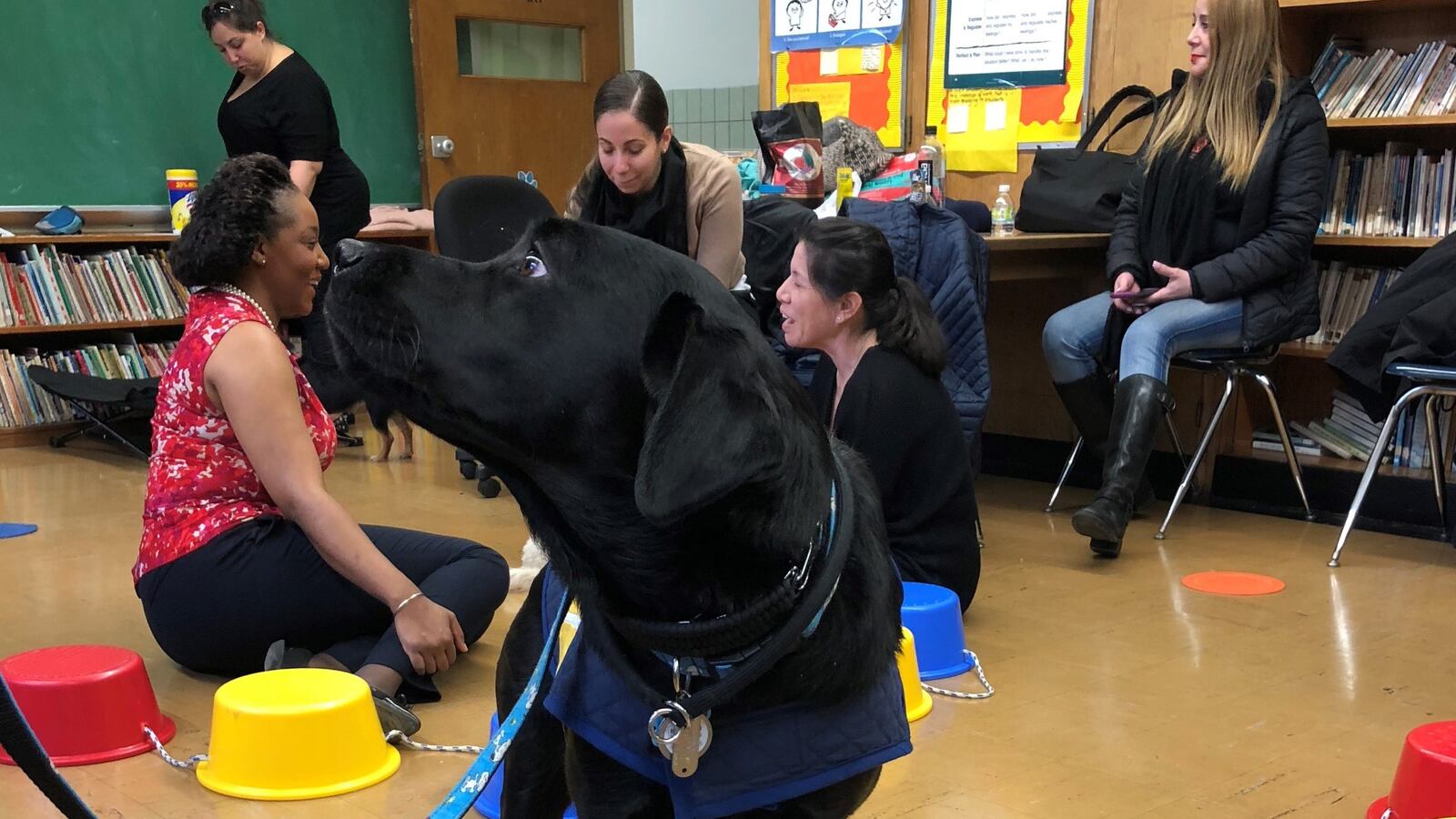Inside the main office of Shell Bank Middle School in Sheepshead Bay, a Post-it note sat on an administrator’s desk beside an empty lunch plate. The note read, “It wasn’t me, love Brody.” On the floor was a leaf of lettuce, the only remaining evidence of a sandwich that once belonged to school aide Sarah Giglio.
“It’s a labor of love,” Giglio said with a laugh as she reached down to pick up the food scraps, referring to life with Brody, the oversized and rambunctious dog that is one of five comfort dogs who spends all day at the school.
Classroom-ready comfort dogs have been a part of school life in New York City since 2014. Now in 45 schools, the comfort dog program will expand to 60 schools by the end of the school year, the city announced last week.
But Shell Bank, also known as J.H.S. 14, pioneered the approach. It was the first school in New York City to enroll in the Department of Education’s Comfort Dog program and the first city school to take part in the “Mutt-I-Gree Curriculum,” a nationwide curriculum developed by Yale University and North Shore Animal League. The program’s goal is to use the love between children and dogs to teach empathy, cooperation, self confidence and other life lessons.
Thanks to early success at schools like Shell Bank, comfort dogs are now walking the hallways and visiting classrooms in more than 4,000 schools across the United States and Canada. While the dogs played a visible role comforting students after the shooting in Parkland, Florida, the animals are also part of the day-to-day lives of students facing a variety of challenges.
In 2013, Teri Ahearn became principal at Shell Bank, a school that serves more than 500 students in grades six through eight, about 91% of whom receive free or reduced price lunch, according to city data. During her first year there, she invited puppies from North Shore Animal League to a school assembly to teach the students about empathy and respect. A teacher fell in love with a gray and white border collie, adopted the animal, and later brought the dog, named “Shelby” after the school’s name, to Shell Bank every day. The well-trained and timid pup helped Principal Ahearn see the value of having a therapy dog in the academic workplace in conjunction with the Mutt-I-Gree curriculum and pitched it to then-New York City Schools Chancellor Carmen Fariña and Superintendent Julia Bove, who gave it the go ahead.
Shelby became the first of her kind, assisting in the school’s Mutt-I-Gree elective, a class based around the unique characteristics that develop from taking care of a shelter pet. “The school bought into it from the very beginning,” said Ahearn. “Even the custodians, which is important because accidents happen.”
The Mutt-I-Grees curriculum was developed in 2010 by Matia Finn-Stevenson, Director of Yale University’s School of the 21st Century, in an effort to bring social-emotional learning skills into the classroom. The School of the 21st Century researches and develops a wide-range of national models that helps educators create lesson plans. The curriculum focuses on fostering empathy, decision-making skills, and cooperation among students.
Once implemented, the program’s impact was analyzed by Yale researchers, finding that it resulted in significantly higher levels of empathy, prosocial behaviors, and a positive school climate.
Principal Ahearn argues that it is not only benefitting her students socially, but it is academically rewarding as well. That’s why she’s strict about keeping her office door open so that students dealing with anything from relationship issues to academic problems can come and play with the dogs whenever they choose.
Given students and teachers’ love for Shelby, it did not take long for Brody, Molly, Laney, and Banksy to join the school. The dogs live with different teachers from Shell Bank and are trained by both North Shore Animal League as well as a private trainer hired by the school. Though all instructed by the same trainers, each dog has adopted different roles at Shell Bank. Banksy works directly with the school’s guidance counselor as a therapy dog. Bruno has the ability to break up fights between classmates by gently nudging his head in the middle of a dispute. The dogs have been monitors in the halls, as well as comic relief in the middle school’s increasingly competitive academic environment. Ahearn can often be seen in her high heels walking the dogs around the school while children look out the window at her and laugh at the sight.
“I answer the phone, I pick up poop,” said Ahearn. “Seeing the kids excited about this trumps every critique of dogs being allowed in school.”
Indeed, there are some health concerns. In an effort to be transparent about the program, Ahearn distributes waivers at the beginning of each school year informing parents that dogs are on school grounds. Last year was the first year Shell Bank had some students allergic to dogs. Other parents instruct their children not to pet them because of cultural deterrents. One family believes dogs carry dirt and disease, so safeguards must be in place to prevent an encounter between the child and any one of the five pets.
Though she has yet to face complete opposition, Ahearn said the program would not work unless it is 100-percent structured and carefully analyzed to understand each student’s needs. And she was happy to hear about the program’s expansion last week.
“They can be such an asset to the schools themselves if used effectively,” she said of the dogs. “It is so multifaceted that you don’t realize how many times a dog can be utilized with kids. They are conversation starters, teach lessons on friendship, an outlet for expressing feelings.”

